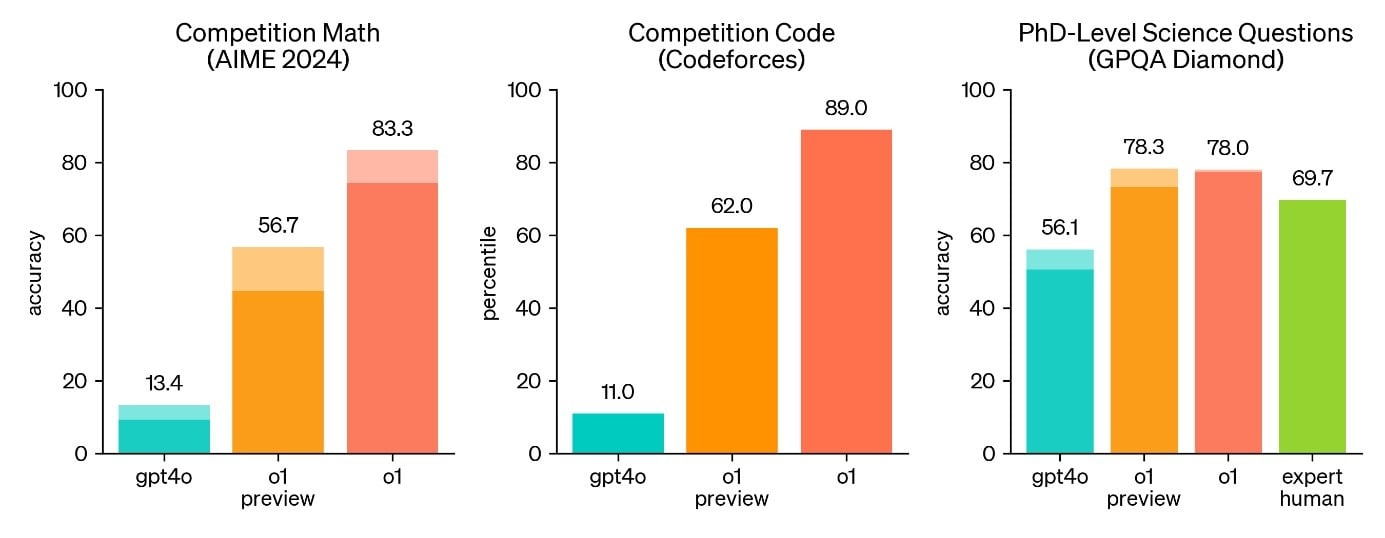Naming: “ChatGPT o1” or “OpenAI o1”?
While previous OpenAI models like GPT-3 and GPT-4 were clearly named by generations, the name “o1” marks a deliberate break from this tradition. The decision to leave the name “GPT” behind is profound and symbolizes the beginning of a new paradigm in AI: moving away from purely data-based text sequence prediction to an AI capable of thinking, reasoning, and continuously adapting in real-time. While previous models specialized in natural language processing and sequence prediction, OpenAI has created a series with o1 that focuses on solving problems requiring deep logical understanding and analytical thinking. This makes the o1 models particularly suitable for complex scientific and mathematical tasks that were previously considered difficult to automate. However, the o1 models are slower in processing speed compared to GPT-4o. The o1-preview model achieves 23 tokens per second, the o1-mini 74 tokens per second, while GPT-4o operates at 94 tokens per second. (Source: https://artificialanalysis.ai/models/o1#speed)
Transform your business with cutting-edge AI solutions tailored to your needs. Connect with our experts to start your AI journey today.
Chain-of-Thought: A Revolution in AI Thinking
A central difference between the o1 models and earlier models like GPT-4 is the “Chain-of-Thought” approach. This allows the AI to undergo a logical thought process, similar to a human tackling a problem step by step. While GPT-4 was trained to predict the next word in a text sequence, o1 goes a step further. The core principle of CoT prompting lies in its ability to guide LLMs through a structured thought process. Instead of expecting an immediate answer, CoT prompting encourages the model to “think out loud” by generating a sequence of logical steps leading to the final answer. By breaking down problems into smaller, manageable steps, LLMs can handle more complex thinking tasks with greater accuracy. This is particularly useful for problems requiring logic, calculation, or multi-step decision-making. CoT even allows LLMs to recognize and correct their own errors in the previous thought process.
Furthermore, CoT provides users with insights into the model’s thought process, allowing them to understand how the AI arrived at its conclusion. This transparency is crucial for building trust in AI systems, especially in critical applications. While CoT prompting can be applied to various LLMs, OpenAI’s o1 series is specifically designed to integrate Chain-of-Thought mechanisms into their response generation process, making them particularly well-suited for complex tasks requiring logical thinking. This method enables the AI to delve deeply into problem analysis and try different approaches until a satisfactory solution is found. This ability to independently recognize and correct errors makes the o1 models a powerful solution for a variety of tasks.
An impressive example of the “Chain-of-Thought” approach’s capabilities is the o1 models’ ability to achieve an 83% success rate in qualifying for the International Mathematics Olympiad, while GPT-4 could only solve 13% of the tasks correctly. This remarkable ability opens new possibilities in areas previously considered too complex for AI automation. According to OpenAI tests, the o1 models can operate at a level comparable to that of doctoral students in subjects like physics, chemistry, and biology.

Source: https://openai.com/index/learning-to-reason-with-llms/
Setting Standards in AI Safety
With the introduction of the o1 models, OpenAI has also made significant advances in AI safety. A key feature of these new models is their ability to independently analyze and apply safety guidelines. This makes it significantly more difficult for users to bypass safety precautions or “jailbreak” the models. Jailbreaking refers to circumventing the security and usage restrictions of LLMs to use them for tasks that are normally not allowed. In tests aimed at bypassing the models’ security mechanisms, o1 performed significantly better than GPT-4, thanks to its enhanced ability for self-reflection and adherence to safety guidelines.
These safety improvements are particularly important as AI models are increasingly used in sensitive areas such as healthcare, scientific research, and programming. OpenAI has worked closely with security authorities in the USA and the UK to ensure that the o1 models meet the highest standards. This collaboration has helped ensure the safety and ethical use of the models.
Comparison Between OpenAI o1 and GPT-4
Although GPT-4 has achieved impressive results in many areas, the o1 series represents a significant advancement. The main difference lies in the o1 models’ ability to think through and solve complex problems step by step. While GPT-4 is geared towards fast natural language processing, o1 is specifically designed for tasks requiring deep understanding and precise conclusions.

Source: https://openai.com/index/learning-to-reason-with-llms/
Another area where o1 excels is programming. In Codeforces programming competitions, the o1 models achieved a result in the 89th percentile, highlighting their ability to excel in complex technical areas. These improvements show that o1 is not just an evolution of GPT-4 but represents a completely new level in AI development.’

Source: https://codeforces.com/blog/entry/133874
Empower your business with AI technology designed just for you. Our experts are ready to turn your ideas into actionable solutions.
Applications of OpenAI o1 Models
The advanced thinking capabilities of the o1 models make them a valuable resource in various industries. In particular, the o1 models offer significant advantages in science, programming, and healthcare. In medical research, for example, they can help annotate cell sequencing data, significantly increasing research efficiency.
In software development, the o1 models offer new possibilities. Their ability to recognize and fix complex errors can help developers optimize workflows and find precise solutions to difficult programming tasks. The ability to efficiently manage multi-step workflows makes the o1 models an indispensable tool in modern software development.
Let our AI specialists help you build intelligent solutions that propel your business forward. Contact us to start transforming your vision into reality.
Outlook: The Future of Artificial Intelligence with OpenAI o1
With the ability to think deeply and solve complex problems, the o1 series opens new perspectives for the use of AI in various fields. The advances in safety and ethical responsibility make these models a promising option for companies and research institutions.
It will be exciting to see how the o1 models will continue to develop. Their ability to solve problems previously considered unsolvable could fundamentally change how we understand and use Artificial Intelligence. It is clear, however, that OpenAI has laid the foundation for a new era of AI with the o1 series, which is not only smarter but also safer and more responsible.
Let’s Bring Your AI Vision to Life
Our AI experts bring your ideas to life. We offer customized AI solutions tailored to your business.

Conclusion
With the introduction of the OpenAI o1 models, the company has revolutionized how we understand Artificial Intelligence. These models are not only capable of solving complex problems but do so in a way that involves deep logical thinking. The safety and efficiency of these models make them a valuable resource for researchers, developers, and companies in various industries. The future of AI looks promising with the o1 series. While the o1 models are already delivering impressive results, it remains to be seen what further innovations OpenAI will introduce in the coming years. One thing is certain: the o1 series has the potential to significantly expand the boundaries of what AI can achieve and usher in a new era of problem-solving.

